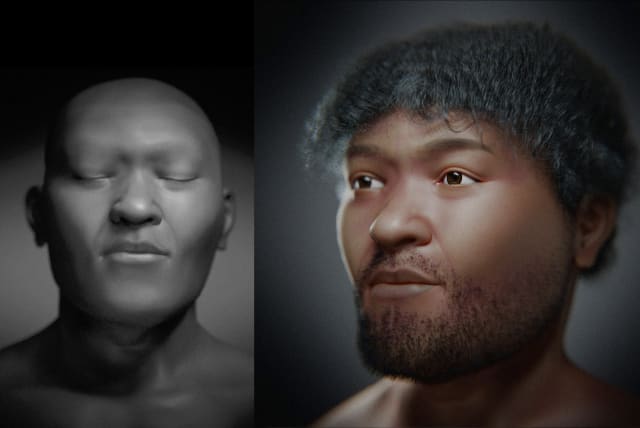Scientists reconstruct 35,000 year old face - study

The skeleton, per the scientific report, was discovered in 1980 in the Nile Valley in Egypt.
Brazilian scientists recently completed an updated analysis of an ancient Egyptian skeleton and were able to determine, with a considerable degree of certainty, what the individual looked like in life.
Archaeologist Moacir Elias Santos, and 3D designer Cícero Moraes used the skeletal remains to recreate a digital image of the 35,000-year-old man, who has been given the name Nazlet Khater 2 (NK2) after the name of the archaeological site.
The skeleton, per the scientific report, was discovered in 1980 in the Nile Valley in Egypt. NK2 was buried alongside a stone axe, which was easier to date than the bones themselves, although dating tests were eventually done on the teeth. NK2 was, according to researchers' best estimates, 17-20 years old at the time of his death tens of thousands of years ago.
What do we know about NK2?
NK2 was male and 161-165cm tall. The bones in his legs were somewhat bent and he had lesions in his vertebrae, indicating a life of hard physical labor, possibly mining.
"The skeleton has most of the bones preserved, although there have been some losses, such as the absence of ribs, hands, [the] middle-inferior part of the right tibia [shin bone] and [the] lower part of the left tibia, as well as the feet," Santos told science website LiveScience in an email. "But the main structure for facial approximation, the skull, was well preserved."
"The skull, in general terms, has a modern structure, but part of it has archaic elements, such as the jaw, which is much more robust than that of modern men," Moraes told Live Science in an email. "When I observed the skull for the first time, I was impressed with that structure and at the same time curious to know how it would look after approaching the face."
The team used forensic facial reconstruction (FFR) to reconstruct NK2's face. The study authors noted that FFR is not an identification technique like DNA or dental identification. Rather, it is an auxiliary tool meant to aid in the identification process. In this case, it was used to reconstruct missing sections of the skull and generate facial features based on the skull's structure.
"A few years ago, we were already working on a series of approximations related to human evolution, with the best-known fossil replicas," Santos told CNN. "The videos were converted into photos and were used for the elaboration of the photogrammetry of the skull, which shaped the study."
Moraes took care to point out that digitized facial reconstruction is not a foolproof technology, and that the reality is not as glamorous as film and television may portray.
"In general, people think that facial approximation works like in Hollywood movies, where the end result is 100% compatible with the person in life," Moraes said to LiveScience. "In reality, it's not quite like that. What we do is approximate what could be the face, with available statistical data and the resulting work is a very simple structure.
"However, it is always important to humanize the individual's face when working with historical characters, since, by complementing the structure with hair and colors, the identification with the public will be greater, arousing interest and — who knows — a desire to study more about the specific subject or archeology [and] history as a whole," he added.
Jerusalem Post Store
`; document.getElementById("linkPremium").innerHTML = cont; var divWithLink = document.getElementById("premium-link"); if (divWithLink !== null && divWithLink !== 'undefined') { divWithLink.style.border = "solid 1px #cb0f3e"; divWithLink.style.textAlign = "center"; divWithLink.style.marginBottom = "15px"; divWithLink.style.marginTop = "15px"; divWithLink.style.width = "100%"; divWithLink.style.backgroundColor = "#122952"; divWithLink.style.color = "#ffffff"; divWithLink.style.lineHeight = "1.5"; } } (function (v, i) { });

